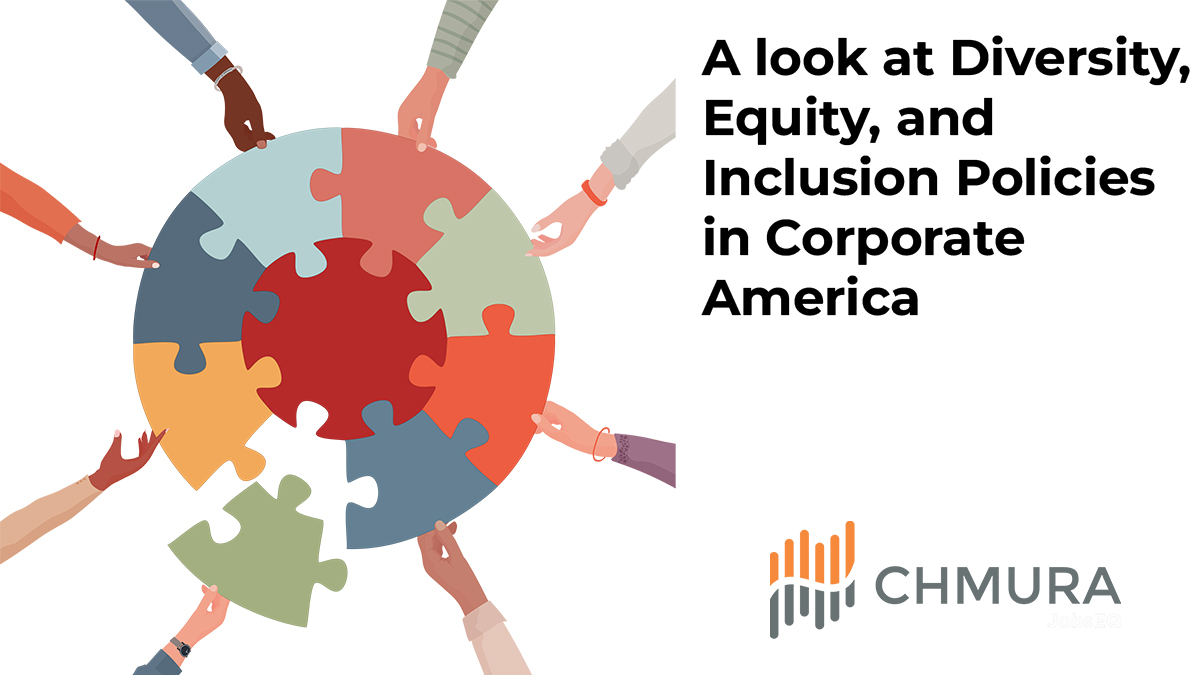A look at Diversity, Equity, & Inclusion Policies in Corporate America

Diversity, Equity, and Inclusion (DEI) practices are becoming increasingly important in organizations and companies across the United States. Corporate America has been turning its attention to diversity in the wake of movements like MeToo and Black Lives Matter. Results of a 2021 survey from WorldatWork indicated that 83% of organizations had been pursuing DEI initiatives in 2021, 29% of whom reported undertaking these policies within the past 12 months. WorldatWork also surveyed employees of these organizations to further evaluate their DEI policies. Within their workplaces, 85% of employees believed that DEI policies were prioritized a “good” or “great deal,” and 85% “agreed” or “strongly agreed” that they felt included.[1} Existing literature and research studies provide further context regarding the inner workings of modern, or “new-era,” DEI policies.
All companies confront the problem of finite resources. With fixed budgets, companies often search for policies that maximize a given outcome per dollar spent. Many corporations throughout America utilize annual bias training due to its low cost and protection from legal action, but studies show that its effectiveness is limited. A recent study found that only eight of the 17 most promising bias training programs significantly reduced implicit bias, with the effects dissipating after 24 hours.[2] Other studies corroborate these results and encourage moving away from traditional bias training programs and towards DEI initiatives aimed at restructuring existing processes. Examples of such policies, at a broad level, include:
- Tracking diversity through the recruitment and interview processes
- Conducting internal pay audits
- Conducting climate surveys of workplaces to gauge employee-employer alignment on DEI goal progress
- Organizing diversity-oriented programs that allow employees to reflect on diversity both inside and outside the workplace
- Establishing settings in which disadvantaged groups can share their experiences with co-workers and one another
- Extending DEI on-boarding trainings to take place over the course of a month as opposed to a week
- Establishing welcoming and inclusive messaging
- Establishing processes that bypass interpersonal bias
- Establishing organizational responsibility for DEI initiatives [3, 4]
Beyond these examples, some consensus exists on what characteristics foster effective DEI policies. As previously mentioned, one of the core elements of “new-era” DEI policies have been those that fundamentally restructure existing processes. Though perhaps not explicitly discriminatory, many existing practices may be implicitly biased. Redesigning these processes with a focus on DEI can be useful in reaching diversity-related goals. Additional guidelines include educating organization members about bias and DEI efforts and fostering responsibility for DEI goals. While annual bias training may not be as effective as some ”new-era” DEI policies, coupling these trainings with policies such as those previously listed can increase their effectiveness.[5]
Many “new-era” DEI policies have been adopted at increasing rates over the last few years. For example, the aforementioned WorldatWork survey reported that 97% of DEI-active organizations have an established DEI strategy, and 57% of all organizations have established metrics to evaluate DEI results. Out of the organizations tracking DEI metrics, 91% and 89% are geared towards workforce representation and recruiting respectively.[6] Another of the previously cited studies found that 74% of respondents tracked the diversity of new hires while another 64% track the diversity of those they recruit.[7] The positive trend in DEI policies should provide encouragement for organizations across America hoping to reach their DEI goals.
While Chmura’s white paper mentions the sizeable progress on diversity-related goals over the last few years and prior decades, the report also discusses the strides left to be made. The data and existing literature around DEI policies tell a similar story. Promising work has been done over the last few years, but further efforts need to be made to encourage equity in America’s workforce. Many of the “new-era” DEI policies are relatively low in cost, easy to implement, and have already shown to be quite effective. Consequently, even with constrained resources and a focus on efficiency, widespread adoption of “new-era” DEI policies would improve the existing positive trend in DEI goals.
-----------
[1] Jim Fickess, “Trends in DEI Practices and Policies”, WorldatWork Newsletter, September 28, 2021
[2] Ivuoma Onyeardor et al., “Moving Beyond Implicit Bias Training: Policy Insights for Increasing Organizational Diversity”, Policy Insights from the Behavioral and Brain Sciences, Vol. 8(1) (2021): 19-26.
[3] Bernadette Baum, "Diversity, Equity, and Inclusion Policies: Are Organizations Truly Committed to A Workplace Culture Shift?" Journal of Business and Behavioral Sciences, Vol. 33(2) (2021): 11-23.
[4] Onyeardor et al., “Moving Beyond Implicit Bias Training”, 19-26.
[5] Baum, "Diversity, Equity, and Inclusion Policies", 11-23.
[6] Fickess, “Trends in DEI”, 1-4.
[7] Baum, "Diversity, Equity, and Inclusion Policies", 11-23.
Subscribe to the Weekly Economic Update
Subscribe to the Weekly Economic Update and get news delivered straight to your inbox.











